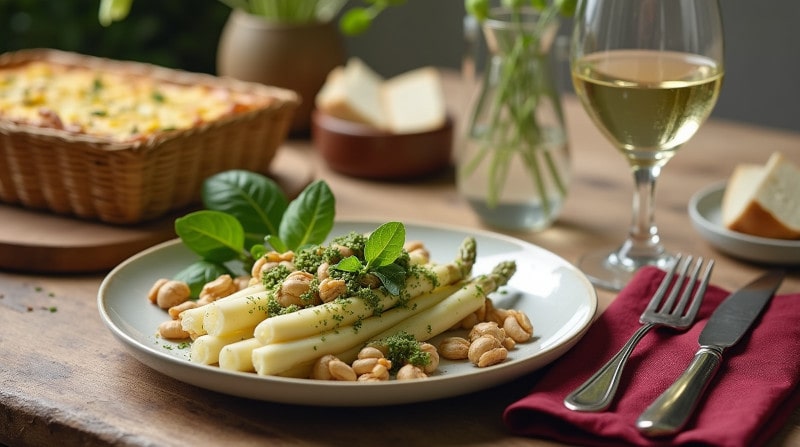Spring-fresh, flavoursome and perfectly accompanied by Grüner Veltliner
An aromatic spring dish in which tender white asparagus is combined with a flavoursome wild garlic pesto and crispy roasted hazelnuts. The harmonious combination of freshness and nuttiness is ideally complemented by a Grüner Veltliner.
Ideal wine accompaniment: Grüner Veltliner (DAC Kamptal, Austria)
The Grüner Veltliner from the Austrian Kamptal region impresses with its peppery flavour, lively acidity and fresh citrus notes. These characteristics harmonise perfectly with the intense wild garlic pesto and roasted hazelnuts. The freshness of the wine underlines the delicate flavour of the white asparagus, while its spiciness complements the flavours of the dish. A Grüner Veltliner with a short maturation period brings additional vibrancy to the combination.
Further wine recommendations:
Sauvignon Blanc (AOC Sancerre, France): With its lively acidity and flavours of green apple and gooseberry, this wine complements the freshness of the wild garlic pesto and the delicate asparagus.
Pinot Blanc (AOC Alsace, France): The fine fruit and balanced acidity of this wine harmonise well with the spicy wild garlic pesto and roasted hazelnuts.
Chenin Blanc (AOC Vouvray, France): With its fine fruit and light honey notes, this wine offers an interesting complement to the spicy wild garlic pesto and roasted hazelnuts.
Vermentino (DOC Vermentino di Sardegna, Italy): The lively acidity and fresh citrus notes of this wine complement the freshness of the wild garlic pesto and the delicate asparagus.
Furmint (Tokaji, Hungary): The dry Furmint from the Hungarian Tokaj region impresses with its mineral freshness, fine citrus notes and a precise, lively acidity structure. These characteristics harmonise wonderfully with the green spice of wild garlic pesto and the light roasted aroma of hazelnuts. The elegant dryness of the Furmint emphasises the freshness of the white asparagus, while its mineral depth lends structure to the dish. Furmint from barren, stony vineyards with subtle ageing in large wood is particularly exciting – complex, but not overloaded.
The recipe:
White asparagus with wild garlic pesto and roasted hazelnuts
Cooking utensils
- 1 Pot
- 1 Pan
- 1 Blender or hand blender
- 1 Chopping board
- 1 Knife
Ingredients
For the asparagus:
- 500 g white asparagus
- 1 tsp sugar
- 1 teaspoon salt
- 1 Tbsp butter
For the wild garlic pesto:
- 100 g fresh wild garlic
- 50 g Roasted hazelnuts
- 50 g grated parmesan
- 100 ml Olive oil
- Salt and pepper to taste
For the topping:
- 30 g Roasted hazelnuts roughly chopped
Preparation
Asparagus:
- Peel the asparagus and remove the woody ends.
- Bring water, sugar, salt and butter to the boil in a pan.
- Cook the asparagus in the pan for approx. 10-15 minutes until al dente.
Wild garlic pesto:
- Wash and roughly chop the wild garlic.
- Add the roasted hazelnuts, grated Parmesan and olive oil.
- Blend everything with a mixer or hand blender to a creamy consistency.
- Season to taste with salt and pepper.
Dressing:
- Arrange the asparagus on plates.
- Drizzle with wild garlic pesto and sprinkle with coarsely chopped, roasted hazelnuts.
Recommended side dishes:
- Potato gratin with herbs
- Fresh leaf salad with lemon vinaigrette
- Toasted sourdough bread with butter

